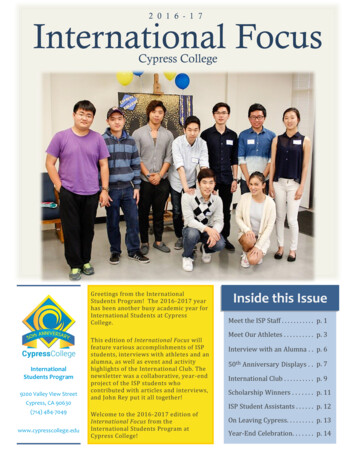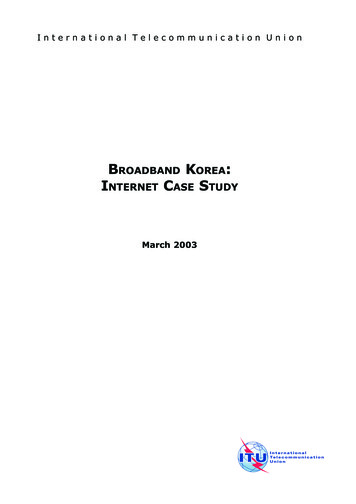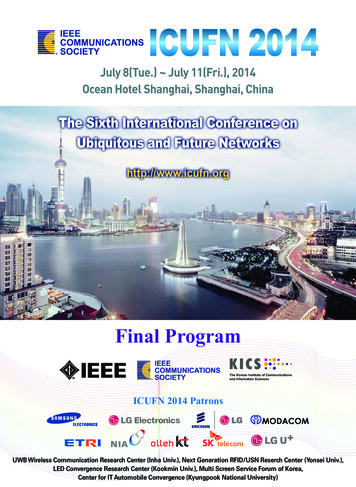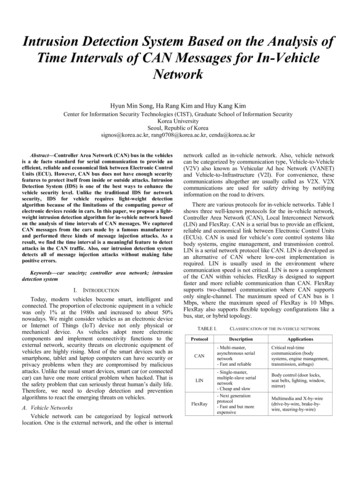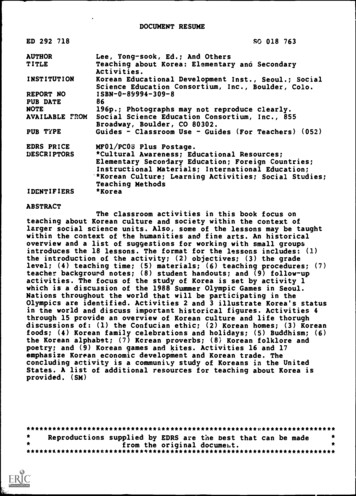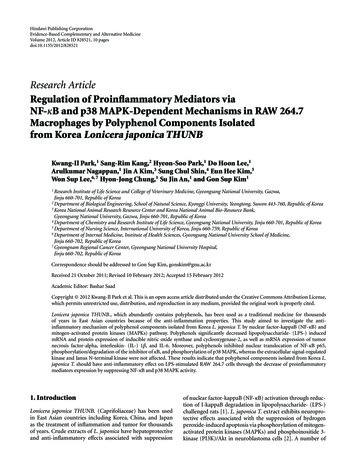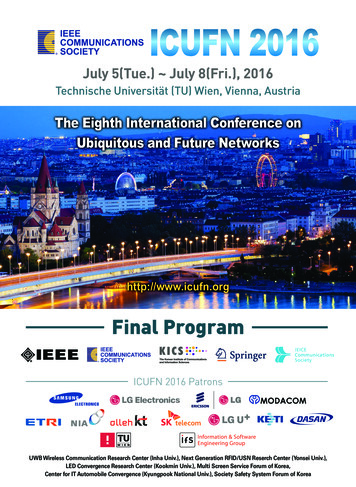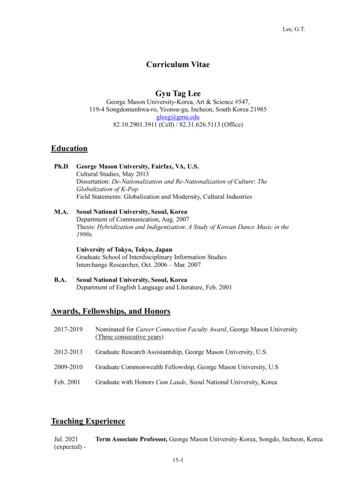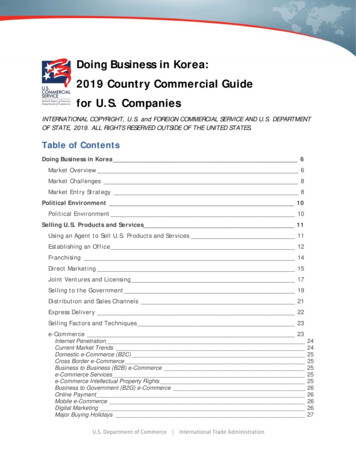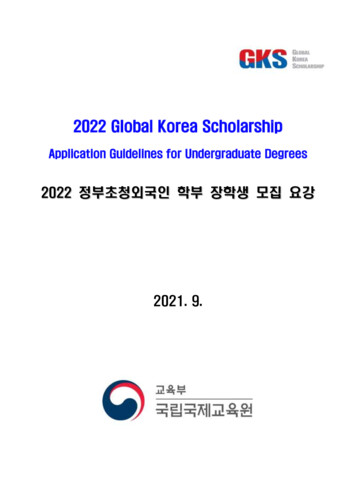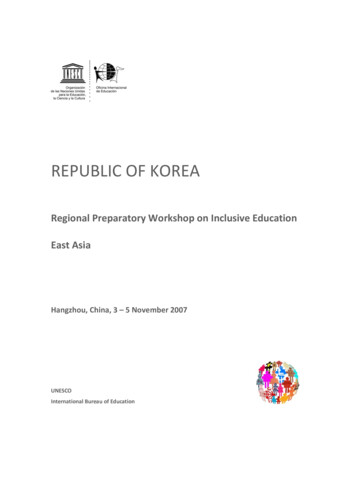
Transcription
REPUBLIC OF KOREARegional Preparatory Workshop on Inclusive EducationEast AsiaHangzhou, China, 3 – 5 November 2007UNESCOInternational Bureau of Education
Inclusive Education in the Republic of KoreaKye-Ok KIM, Educational ResearcherSpecial Education Policy DivisionMinistry of Education & Human Resources DevelopmentRepublic of KoreaCountry Paper for the Regional Preparatory Workshop on Inclusive EducationNovember 3, BeijingIn Korea, the Constitution, Education Law, Special Education Law,and other regulations guarantee equal educational opportunities for allchildren. Article 31 of the Constitution of the Republic of Korea stipulatesthat every citizen shall have a right to receive education according to his orher ability and aptitude, and mandates all citizens to have their childrenreceive compulsory primary and secondary education, and education asrecognized in legislation.In accordance with the Constitution, Article 4 ofthe Framework Act on Education states that there shall be an equalopportunity of education for all, where no citizen shall be discriminatedagainst in education for reasons of sex, religion, faith, social standing,economic status or physical conditions, etc.Based on the laws and regulations, various policies are beingestablished and implemented to support education for all children. Usuallythe concept of 'inclusive education' is understood as policies ensuringeducational access at regular schools for students with disabilities. At theKorean Ministry of Education and Human Resources Development, a numberof divisions are responsible for supporting different children groups. TheSpecial Education Policy Division is in charge of the inclusion of children withdisabilities and children with learning difficulties. The Educational WelfarePolicy Division oversees matters related to children from low income families,
children from North Korean refugee families and children from multi-culturalfamilies. The Elementary and Secondary Education Policy Division devisesand implements policies to support children that have low academicachievement levels.Primarily, Koreans are a homogeneous people, with little differencebetween ethnicity. However, with the growth of foreign nationals in thecountry in recent years, it is becoming increasingly necessary for Korea to takeinto account a wider diversity of learners including children from differentethnic backgrounds.Nowadays, children who do not speak at school, children with geniustalents, children who are slow in every activity due to obesity, children offoreign workers, and children who wander around during class, can be foundeasily at general schools. These are examples of children who need specialattention and assistance. Although public attention for these children havesomewhat come into existence thanks to the supportive promotion activities ofcelebrities, international marriages have been on the rise following the increaseof foreign worker influx, and thus, there should obviously be moreconsideration for these cases.In response to changing demands, the ministry launched a Five-yearEducation Welfare Plan for Students with Disabilities in 1994. In 1998, theministry initiated more supportive policies such as providing free education for5-year-olds from low income families, and giving out free computers toeconomically underprivileged students. Since 2003, as a part of the HumanResource Development Plan, the ministry has also provided support foradolescents who have not been able to continue studies. Added to these, therehave also been concrete educational policies responding to the increase offoreigners and international marriages, and other changes in particular political,economic, domestic and international societal environments.Inclusive Education for Students with DisabilitiesIn Korea, 65,940 students receive special education services as presentesin Figure1 . Among them 42,977 students are integrated in regular schoolsetting. Inclusive education was first stipulated in the Special EducationPromotion Law in 1978. Since then, the number of disabled students beingplaced within the regular education system has seen a rapid increase.
Under the Law, in order to assure the quality of education for studentswith disabilities, the ministry develops instructional material for students andteachers, provides in-service teacher training programs on curricular revision,and supports the placement of teacher aides.The Special Education Promotion Law stipulates free education for allstudents with disabilities. Elementary and middle school courses must also beprovided as compulsory education for all disabled students.Recently, in May 2007, in order to accommodate growing demands fromparents and the diversifying needs of a rapidly changing society, the SpecialEducation Promotion Law was revised into the Special Education Law for theDisabled and those with Special Needs. Major changes include the stipulationof free and compulsory education for students with disabilities fromkindergarten through high school, free education for 3-year-olds and youngerwho have disabilities or are at risk, and free lifelong education programs foradults with disability.Notably, disability awareness is one of the biggest challenges in regardsto the inclusion of children with disabilities. In Korea, there are on-goingefforts to promote awareness for the needy through schemes such asdeveloping teaching material, movies and animations, and organizing writingcontests. From 2005 the education ministry has also been holding a 'Concert ofHope'. The concert is composed of celebrity musicians with disabilities, whovisit schools to hold special concerts. They usually receive spotlights fromnewspapers and broadcasters, thus contributing to the promotion of disabilityawareness in Korean society. Fig. 1 Current Status of Special EducationRegular SchoolsClassificationNumber of KindergartenStudentsSpecial ng 1,447students in major fields)
Total22,96335,3407,63765,940Number of Schools1444,5303,6218,295Number of Classes3,2785,7536,26315,294Source : Special Education Indicators of Korea (2007); Ministry of EducationPolicies Concerning the Education of Multi-cultural FamiliesKorea has recently been seeing an increase of foreigners coming fromdifferent ethnic and/or cultural backgrounds. In 2006, the Ministry ofEducation established the term ‘multi-cultural families,’ and set forth a series ofcaring policies to support them. For example, the government provides afterschool programs for the children of multi-national families, gives preference forthe children of multinational families to access mentoring programs at colleges,and operates in-service teacher training to promote sensitivity in their care forminority groups.Until only recently, the Korean people have strongly believed that Koreais a homogeneous country. But with the fast increase of internationalmarriages, influx of foreign labor, and permission for the children of illegalmigrant workers to attend regular school, such mind-sets have been changinglately. A single language and same skin color is no longer an obvious view inthe country’s public schools. Figure 2 and Figure 3 show the actual status of children frominternational marriages and foreign migrant worker families. According to2006 statistics, the number of international marriages reached only 3.7percent ofall marriages in Korea. But a year later in 2007(연도 확인 요), there were39,690 international marriages out of a total of 332,752 marriages in Korea,translating into a ratio of 11.9 percent. The percentage is currently continuingan upward move, which has also influenced the growth of multi-culturalchildren. As Figure 1 shows, compared to 2005, over the past two years, thenumber of students from international marriage families has seen an increase of68.4% in elementary schools, 71.9 percent in middle schools and 48.0% in highschools, marking a total of 68.1 percent increase in average. Fig.2 Children of International Marriage Couples
YearElementary SchoolNumber (%)Middle SchoolNumber (%)583High SchoolNumber (%)TotalNumber206 0.6200711,44468.41,58871.941348.013,44568.1 Fig.3 Children of Foreign Migrant WorkersYearElementary SchoolNumber (%)Middle SchoolNumber (%)352High SchoolNumber (%)227TotalNumber 1.62007755-32.339181.9633.31,209-13.0Reports also indicate that there are approximately 630,000 foreignersresiding in Korea. Estimations are that an additional 380,000 are living in thecountry on an illegal status. While the children of legal foreign workers areapt to receive regular educational service, it is very difficult for children ofillegal foreigners to enter elementary or middle school. Even if a child whoseparents are illegal sojourners manage to enter school, it is oftentimes difficultfor him/her to adapt to classes, due to the lack of Korean language proficiency.Added to this, the perception that they are children of low-income foreignlaborers poses more difficulty in adaptation.In an attempt to resolve these problems, the Ministry of Education laidout a comprehensive policy to support the education of children from multicultural families in 2006. At the regional level, Consulting Centers for ForeignStudents’ School Entrance have been established within local offices ofeducation. So far, the education ministry has also published 23 types ofKorean language teaching material for foreign students and teachers, testoperated pilot schools that provide education programs for multi-culturalchildren. The ministry also provided KSL classes and after-school activities for858 children in 97 schools, offered 17 Korean cultural comprehension programs,and operated 17 information and educational programs for multi-culturalfamily parents. In addition, the Ministry of Gender Equality and Family hasbeen working on the establishment of the Multi-cultural Family Support Law, aprocess that goes in line with the goals of Education for All.
Children of North Korean RefugeesThe children of North Korean defectors show a serious deficiency ineducation due to the usually long period of 'defection process'. A portion ofthese students are also known to be suffering from psychological instability dueto 'group bullying' at school, or because of difficulties in adapting to a newsociety. In an attempt to help the children of North Korean defectors betteradjust to secondary school education in South Korea, the Ministry of Education& Human Resources Development announced a comprehensive support planon May 2, 2007 that includes measures to introduce an educational protectionofficer system, provide free after-school programs, improve the academicqualification accreditation system, and develop instructional manuals forclassroom teachers.The plan came as an effort to prevent the students from dropping studiesdue to maladjustment, and help them pursue normal school education in a newenvironment. Currently 1,015 North Korean defector teenagers are studyingin 275 schools and educational institutions across the country in the South.The dropout rate reached 0.8 percent and 1.4 percent among middle school andhigh school students, respectively, in 2005.As a countermeasure, the ministry will first introduce an “EducationProtection Officer” system, and designate teachers who will provideeducational information and counseling for students and undertakeresponsibility for their protection. In 2007, the system will be operated in nineregions, starting with areas with a population of more than ten North Koreanyouth defectors. For an additional 200 students currently enrolled in schools,the ministry will provide free tickets to attend after-school programs during theyear.Steps will be taken to improve the accreditation of North Koreanstudents’ academic attainments, considering the difference of school systemsbetween the South and the North. For these students, the ministry plans toapply a flexible accreditation system that takes into consideration variousfactors including a student’s schooling years, academic performance and abilityand age. Vocational education and career counseling services will also be
provided so that the students may find suitable employment opportunitiesupon graduation.Alongside, recognizing that improving teacher capacity will play acrucial role in the above endeavors, the ministry will open bid for teacher–developed training programs and research projects. Teachers are to designprograms to support defector students, such as mentoring, case studies,education for parents, evaluation sheets, information exchange systems, etc.,and apply for the government’s financial support. Each selected program willbe granted 10 30 million Korean won in aid.In addition, the Hankyoreh Middle and High School will completeconstruction and open doors in 2007 as a specialized school exclusivelyoperated for North Korean youth defectors. The school is expected to functionas a stepping-stone for the students, providing certain periods of basiceducation prior to their transfer to general schools.Support for Students of Low Income FamiliesLow income families generally have a deteriorated household, a veryunstable relationship among family members, and frail educationalbackgrounds. Students of low income families are reported as having lowschool attendance, and in many cases, school drop-outs occur as a result of ahousehold’s economic difficulties.The education ministry has been implementing a “Master Plan to AssistRegions that Require Priority Investment in Educational Welfare”. Priorityregions with many low income families are to receive concentrated educationalwelfare support. Under this plan, the ministry supports the students in the mostneedy areas with orientation and psychotherapy programs, meal provision,health education, after-school voucher program and edu-care for infants andchildren under age 6, in an integrative manner.In rural areas, the ministry groups 2 to 3 schools into one attendanceboundary, so as to manage the support system more effectively. Efforts arealso being expanded to place more excellent educational personnel inintegrated school communities. The Education Ministry designate 60 priorityregions and in total, 30,000 National Basic Livelihood Support students are nowunder support, accounting for approximately 14 percent of all students livingon government aid. The ministry plans to increase this ratio to 25 percent in
2008, by which the number of beneficiary regions is expected to grow to 100.Drop-out Students and Non-Schooled StudentsThe 2004 Five-year Plan for educational Welfare reports that every year,four thousand students drop out from secondary schools. Since elementaryand middle school education is compulsory in Korea, all children areautomatically moved on to the next grade year, even should their basicacademic achievement fall behind.Many problems ensue as students with low academic performance go upto higher levels of education, such as their loss of educational interest, maladaptation behaviors at school, and frequent drop-outs.The ministry set up minimum academic achievement standard andemphasizes teachers’ accountability for basic academic ability. Localeducational offices select students under the minimum academic achievementstandard and support them with after-school activities, utilizing human andmaterial resources in the communities, using supplemental educationalprograms provided by the ministry. They provide incentives to teachers andschools which manage the programs effectively making excellent models.As for drop-outs they implement distance on-line education oralternative school programs drop-outs to continue their studies. There havebeen alternative programs, however, Following the revision of the Primary andSecondary Education Act in 2006, a “Regulation on the Establishment andOperation of Alternative Schools” was approved and promulgated on June 28,2007, opening new possibilities in the provision of alternative education fordrop-out students. The education ministry will continue to provide financialsupport for alternative schools, including teaching/learning material, textbooks,equipment and program operation costs.As such, the Government of Korea is exerting efforts to include allchildren into the educational system and provide appropriate programs toestablish and implement concrete supportive policies. Though there is wideunderstanding among policy makers and schools with regard to Korea’seducation welfare policy, the lack of public awareness is still one of the biggestchallenges. Recently, the government has encountered a sharp increase of
demands from activists or families of children with disabilities. How toeffectively meet such needs and how to pursue educational environmentimprovement in a coordinated and available pace are some of the problems thatthe government will be focusing on in future policy developments. Keeping abalance between levels of support which local educational offices are afford tois also a challenge.
international marriages and foreign migrant worker families. According to 2006 statistics, the number of international marriages reached only 3.7percent of . adjust to secondary school education in South Korea, the Ministry of Education & Human Resources Development announced a comprehensive support plan on May 2, 2007 that includes measures .
